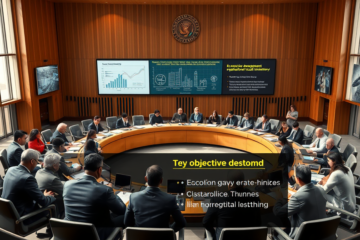Expectation of Selic Rate Reduction Soon
Selic Rate Reduction is a hot topic, especially given the current global economic scenario.
In this article, we will explore how the economic slowdown in the United States and the devaluation of the dollar are contributing to an environment conducive to controlling inflation in Brazil.
Furthermore, we will address the role of the Central Bank in interest rate decisions, the impact on public debt, and expectations regarding the country's economic future.
Finally, we will discuss the fiscal challenges and projections that lead us to believe in a more positive outlook for 2027.
Current Selic Rate Scenario and Expectations of Reduction
Currently, the Selic Rate is at 15% and the expectation of a reduction is considered imminent due to a favorable scenario of inflation control.
The economic slowdown in the United States and the devaluation of the dollar also contribute to this optimistic outlook.
Among the main factors supporting this possible reduction are inflation control, the global economic situation, the need for fiscal adjustments and long-term recovery prospects.
External Factors Supporting the Selic Rate Drop
A US economic slowdown plays a crucial role in reducing domestic inflationary pressures, as it results in lower growth of global demand for resources, reducing import costs for Brazil.
Thus, the significant decrease in inflation in the US contributes to a more stable price environment internationally.
Furthermore, the fall of the dollar, driven by lower inflationary pressure in the US, reduces the cost of imported goods, further easing inflationary tensions in the domestic scenario.
With this, the Central Bank finds more favorable ground to review the Selic rate, thus promoting more favorable economic conditions for sustained economic growth.
Role of the Central Bank in Setting the Selic Rate
O Central Bank plays an essential role in defining the Selic Rate, directly influencing the Brazilian economy.
Copom's decision-making process carefully analyzes the macroeconomic scenario, international factors and inflation expectations.
“As the BC director states, 'the rate needs to reflect inflation conditions',” demonstrates the attention to inflation control.
A autonomy of the Central Bank, guaranteed by its own legislation, is vital for the economic stability, allowing technical decisions, free from short-term political influences.
In a context of economic slowdown in the US and devaluation of the dollar, the expectation of a reduction in the Selic rate becomes more viable.
That autonomy ensures that the bank conducts its policies in accordance with strategic guidelines, adjusting the Selic rate in order to promote sustainable economic growth.
Thus, the Central Bank strengthens the economy and seeks positive surprises for the country's future.
Impacts of Selic on Public Debt and the Budget
The impacts of Selic rate variation in public debt are significant.
With the imminent reduction in the rate, currently set at 15%, a decrease in costs associated with debt service is expected, relieving pressure on the federal budget.
The relationship between the interest rate and public debt is reflected in the government's ability to honor its commitments, directly affecting the availability of resources for other public investments.
Impact Description Consequence Debt interest Increase or decrease in rolling cost More fiscal space Investments Influence on the ability to invest Economic growth Tax burden Changes in revenue and expenditure Tax adjustments
Although expectations for Brazil's economic future are positive, the government recently faced a R$10.7 billion budget freeze.
Despite this, no drastic adjustments are expected, as reported in impact of interest rates on the fiscal crisis.
The scenario, although challenging, gives the government the opportunity to make specific adjustments without drastically compromising its fiscal targets, while anticipating a scenario of positive surprises for the coming years, especially with the forecast recovery of investment grade status by 2027.
Brazil's Fiscal Challenges and Economic Outlook
The Brazilian economy is faced with significant fiscal challenges, amplified by the complexity of the budgetary system and the need for specific adjustments that, although not drastic, are essential for stability.
The R$10.7 billion blockage in the Budget reflects this tension, but the absence of radical changes suggests cautious spending control.
However, the Central Bank is preparing for an imminent reduction in the Selic Rate in a scenario of controlled inflation and economic slowdown in the US.
This move could directly impact public debt, but it opens up possibilities for recovery.
The economic outlook for the country, although uncertain in the short term, looks promising significant improvements in 2027, especially in the recovery of investment grade.
According to the Ministry of Finance, Brazil is on the right path to reestablishing its financial credibility, thanks to an ongoing process of effective adjustments.
Imminent Interest Rate Cut and Benign Inflation Scenario
O imminent interest rate cut arises at a time of favorable economic expectations for Brazil.
The economic slowdown in the United States and the devaluation of the dollar are factors that contribute to a benign inflation scenario.
With inflation under control, the Central Bank has room to consider reducing the Selic rate, currently at 15%.
This potential reduction could trigger a series of positive impacts on the country's economy.
The devaluation of the dollar reduces pressure on the prices of imported goods, helping to keep inflation at a controlled level.
Furthermore, domestic economic activity shows no signs of overheating at this time, which reinforces the viability of an interest rate cut.
Economists, as highlighted in the Copom Statement, note that the Central Bank must act cautiously, but the beginning of the cycle of cuts may occur soon.
In a context where fiscal control remains a challenge, the maintaining confidence in the economy is crucial.
The market already prices this expectation, as pointed out in economic analysis of XP, which sees room for specific adjustments without drastic changes to the budget.
Selic Rate Reduction seems to be an imminent reality, with Brazil heading towards a promising future.
Despite fiscal challenges, expectations of investment grade recovery and a favorable inflationary environment signal a phase of potential growth and economic stability.



0 Comments